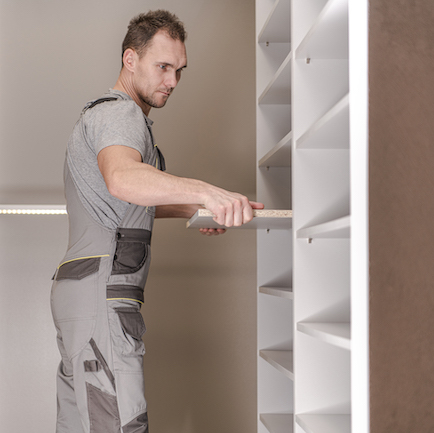
1. Measuring for accuracy
Paying close attention to measuring details and rechecking for accuracy helps guarantee a smoother install. In addition, of course, today’s installers have a battery of new technology at their disposal, such as laser levels, laser measuring devices, and even sophisticated software that can develop templates and measurements from photos.
2. Price the installation separately
Don’t forget to consider installation costs when pricing a job in the first place. Some shops even go so far as to separate installation from the cabinet bid. Typically, they give a firm contracted price for cabinets, but they offer an estimated cost for the building, subject to change based on actual time and materials.
3. Planning, scheduling, and communication
Smooth installs start with good planning and communication. Coordinate with other trades, builders, homeowners, designers, etc. Double-check for any last-minute changes. Some shops go so far as to call the homeowner the night before an installation to remind them and ensure they understand the noise, dust, and disruption the installation may cause.
4. Staging eliminates surprises
Complex jobs should be staged in the shop to ensure everything goes smoothly at the job site. It might seem like assembling a project twice – once in the shop, then on the job site – is a waste of time, but it only takes one miscue to pay off.
5. Tools
Most efficient installers maintain a ready installation tool kit stored in the installation vehicle. That’s much more efficient than raiding the shop for everything you need whenever you go to the job site. In addition, rolling, stackable toolbox systems make it easy to move tools from truck to work zone, and segmented drawers or dedicated pockets make it evident if something is missing when you pack up at the end of the day.
6. Consider some special tools
Here are some special tools not in every installer’s kit but might be worth considering.
Consider a Japanese ryoba instead of a conventional handsaw; it provides both rip and crosscut teeth and typically makes a finer, cleaner finish cut working on the pull stroke.
Blue masking tape works great for scribe lines. First, tape the entire edge of the cabinet to be scribed, then mark the line right on the tape. The line is easier to see, and the tape protects the cabinet when cutting to the line. The blue-type masking tape also comes off cleanly without residue.
Cabinet lifting and propping devices can make it so one person can work more efficiently and safer if you are trying to keep from hiring extra help.
7. Secure and safe shipping
Too many cabinets are damaged in transit. Shrink wrap works better than tape to keep doors and drawers closed and secure in transit. Blanket wraps can provide extra protection. Some shops go so far as to screw down cabinets to the walls and floor of the truck to ensure they don’t shift on the way.
